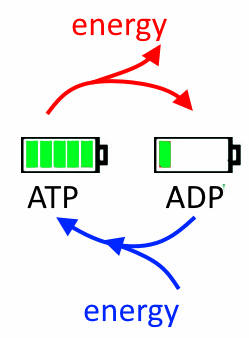








The $ATP$ can be compared to a charged accumulator. His discharge releases energy. The $ADP$ is comparable to an empty accumulator. Its charge consumes energy.

1 : adenine 2 : ribose 3 : phosphate group Hence the name: AdenosineTriPhosphate

This is essentially the case - by hydrolysis : $ATP\;+\;H_2O\;\rightarrow \;H_2PO_4^-\;+\;H^+$ This exergonic hydrolysis ($\Delta G\lt 0$) is not spontaneous because the activation energy is too high. It is often coupled with an enzyme action that lowers this activation energy. - or transfer of the phosphate group : $ATP\;+\;R-OH\;\rightarrow\;R-OPO_3\;+\;$H_2O This transfer, exergonic ($\Delta G \lt 0 $) also, is still under the action of enzymes called kinases
The energy required for this endergonic reaction ($\Delta G \gt 0$) is provided either - by light in the photosynthesis of plants - by the simple transfer of phosphate group still under the action of enzymes called kinases : $R-OPO_3\;+\;H_2O\;\rightarrow \;ATP\;+\;R-OH $ - by reducing $O
$ ATP $ and $ GTP $ (guanosinetriphosphate) are similar in structure and role. See → here)